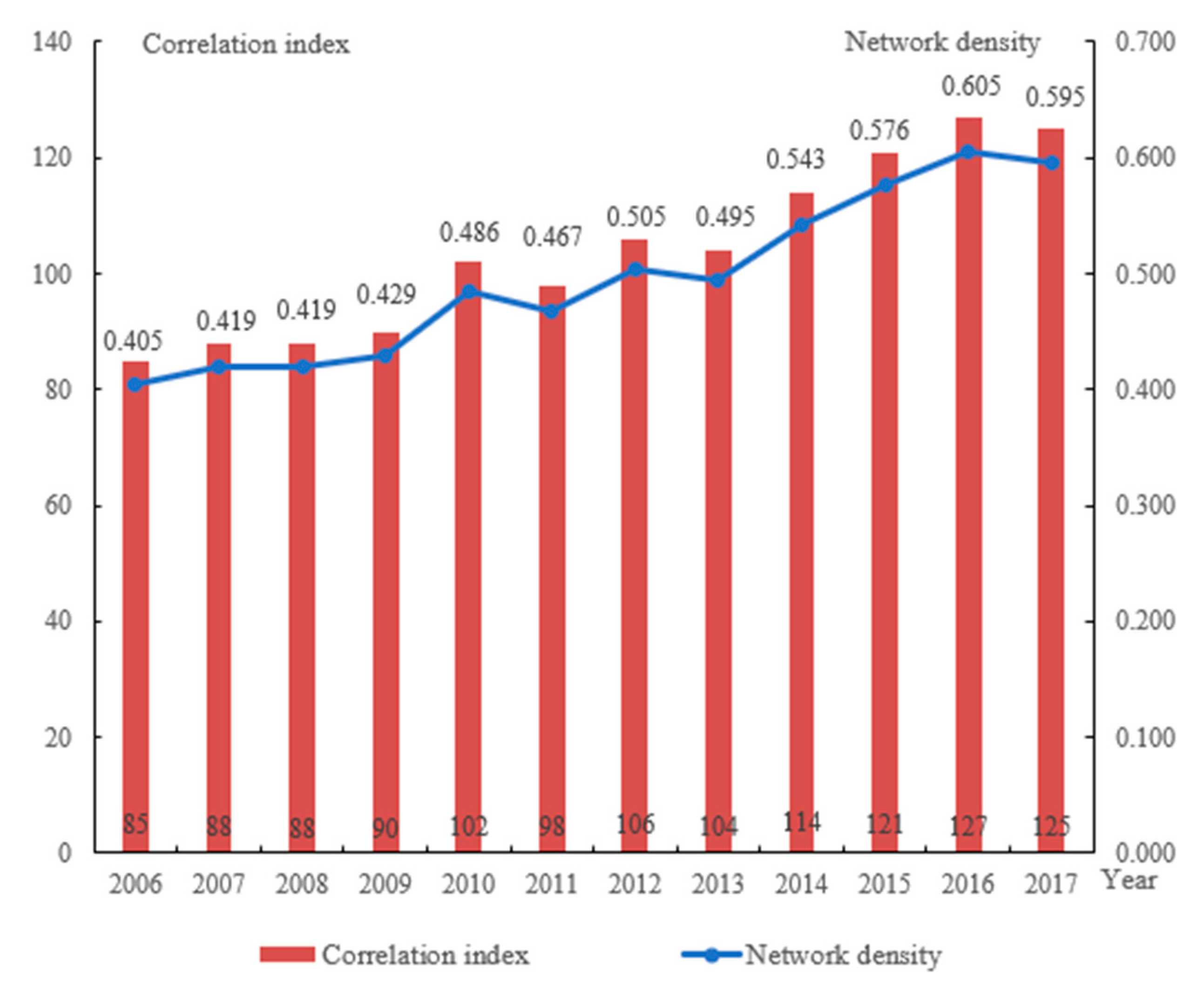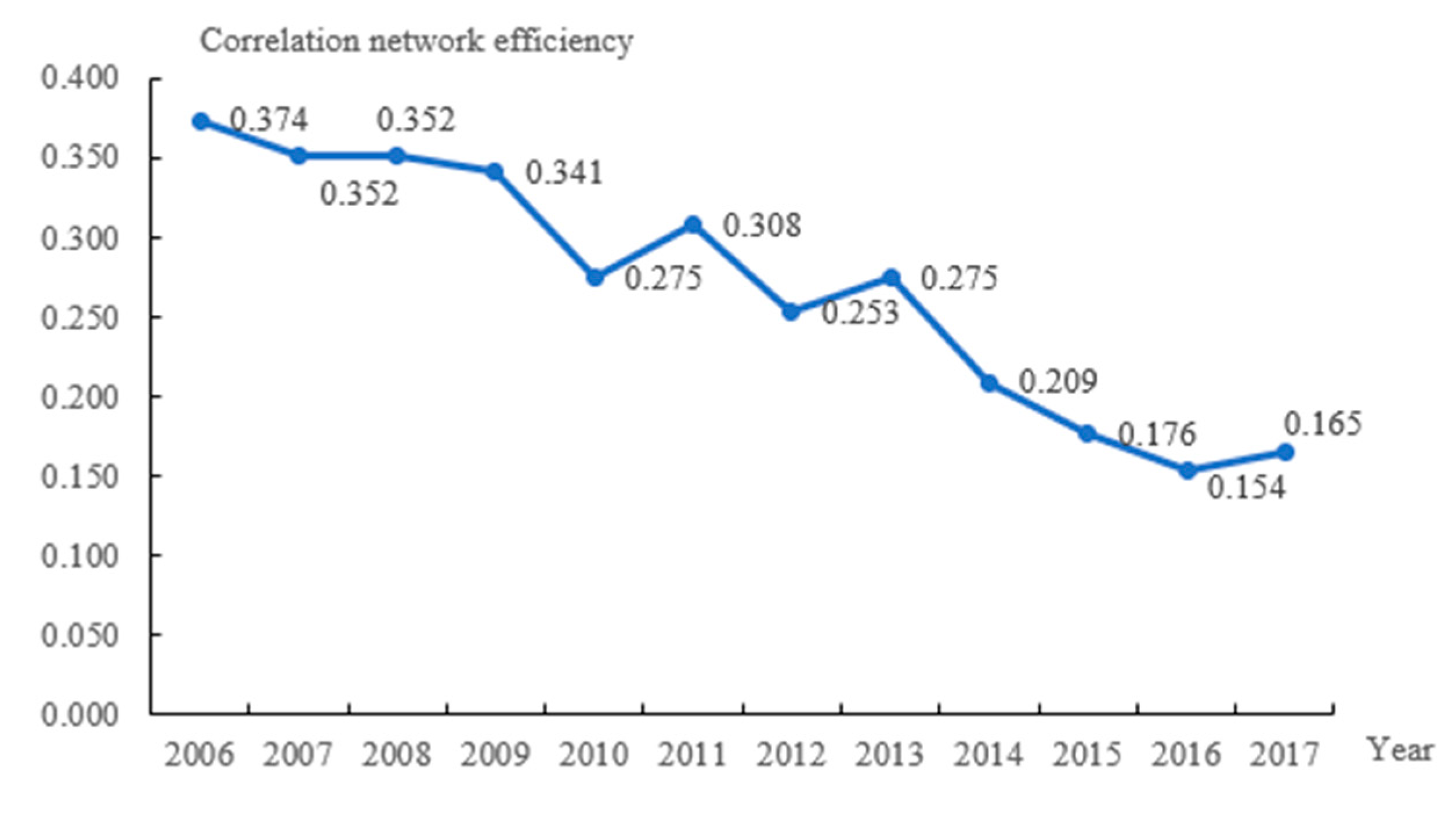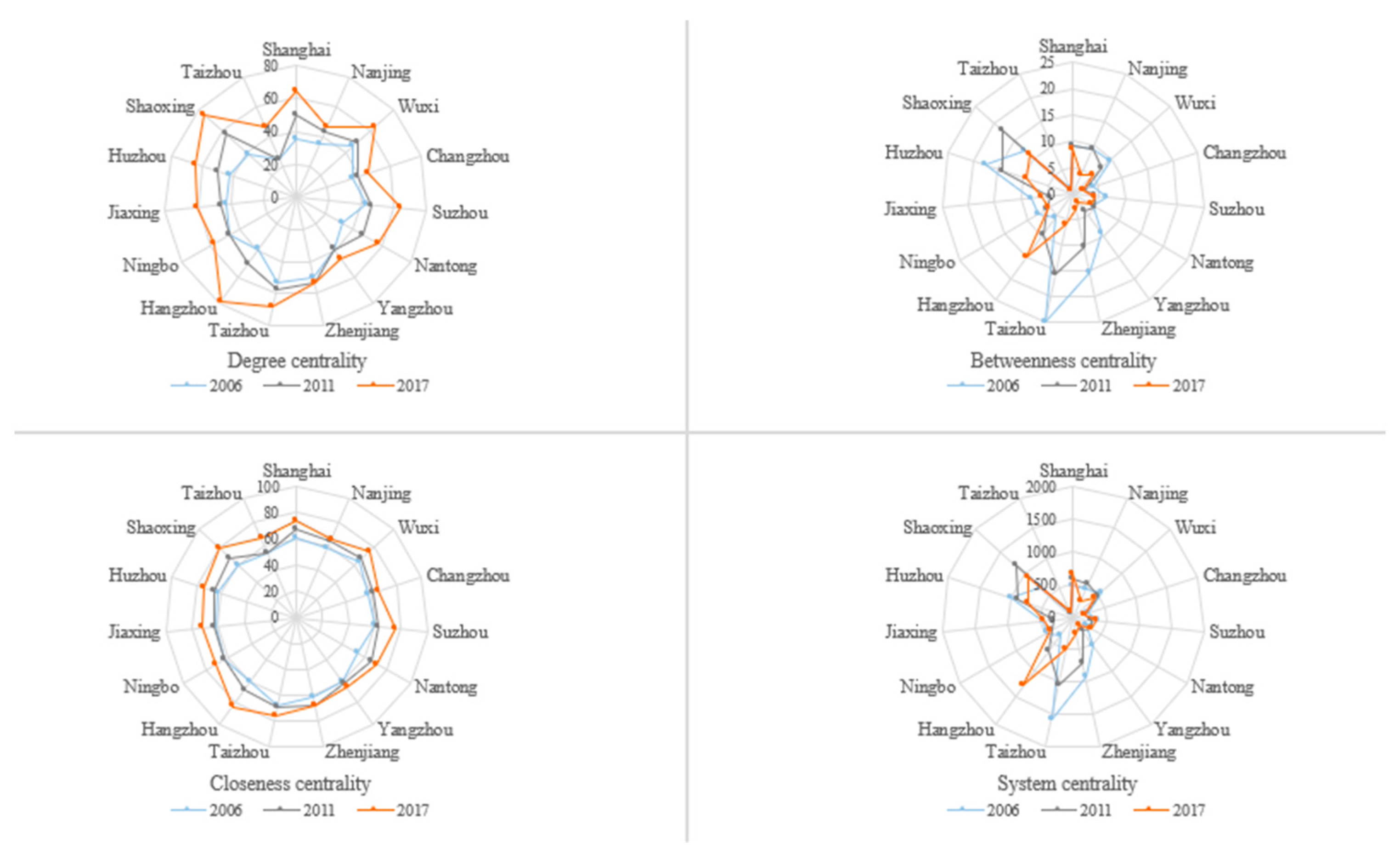Evaluation of the Governance Efficiency of Water Environmental Governance Efficiency in Yangtze River Delta from the Perspective of Multivariate Synergies
Abstract
:1. Introduction
2. Materials and Methods
2.1. Study Area
2.2. Research Methodology and Data Processing
2.2.1. Driving Force-Pressure-State-Impact-Response Analysis Model (DPSIR)
2.2.2. Technique for Order Preference by Similarity to an Ideal Solution method (TOPSIS)
2.2.3. Social Network Analysis (SNA)
2.3. Data Sources
3. Results
3.1. DPSIR–TOPSIS-Based Comprehensive Evaluation of the Governance Efficiency of Water Environment
3.1.1. Analysis of DPSIR Subsystem
3.1.2. Overall Evaluation of the Governance Efficiency of Water Environment
3.2. Multi-Coordination Analysis of the Governance Efficiency of Water Environment
3.2.1. Analysis of Multiple Actors for the Governance of Water Environment
3.2.2. Analysis of Coordinated Governance of Water Environment in Yangtze River Delta
- (1)
- Overall Structural Characteristics of the Network
- (2)
- Individual Centrality Analysis of the Network
4. Conclusions
5. Reflections
Author Contributions
Funding
Institutional Review Board Statement
Informed Consent Statement
Data Availability Statement
Conflicts of Interest
References
- Jiang, H.; Lei, H.; Bai, L.; Wu, H.; Zhao, H.Y. Regional Livestock Waste Resource Utilization Management Modes in the Taihu Lake Basin. Resour. Sci. 2015, 37, 2430–2440. (In Chinese) [Google Scholar]
- Wang, J. Research Status and Prospect of Urban Sewage Treatment Performance Evaluation. Environ. Dev. 2018, 30, 70–72. (In Chinese) [Google Scholar] [CrossRef]
- Zhou, L.; Xu, J.G. Comprehensive Evaluation and Driving Factors Analysis of Water Pollution Prevention Capability on a Large-scale Basin: Taking Huaihe River Basin as an Example. Geogr. Res. 2013, 32, 1792–1801. (In Chinese) [Google Scholar] [CrossRef]
- Gao, S.; Wei, Y.H.; Chen, W.; Zhao, H.X. Study on Spatial–correlation Between Water Pollution and Industrial Agglomeration in the Developed Region of China: A Case Study of Wuxi City. Geogr. Res. 2011, 30, 902–912. (In Chinese) [Google Scholar] [CrossRef]
- Meng, Y.; Lan, W.G. China Water Network. Why is China’s Water Pollution Control Not As Effective As It Should Be? [EB/OL]. Available online: http://www.h2o–china.com/news/view?id=280788&page=1,2020–03–04 (accessed on 5 February 2020). (In Chinese).
- Hernández-Sancho, F.; Sala-Garrido, R. Technical Efficiency and Cost Analysis in Wastewater Treatment Processes: A DEA Approach. Desalination 2009, 249, 230–234. [Google Scholar] [CrossRef]
- Renzoni, R.; Germain, A. Life Cycle Assessment of Water: From the Pumping Station to the Wastewater Treatment Plant (9 pp). Int. J. Cycle Assess. 2007, 12, 118–126. [Google Scholar] [CrossRef]
- Xia, J.; Huang, H. Impacts of Water Pollution and Shortage on Economic Development of the Haihe River Basin. Resour. Sci. 2006, 28, 2–7. (In Chinese) [Google Scholar] [CrossRef]
- Sun, Y.Y.; Song, Y.T.; Wang, H.L.; Bu, N.S. Research on the Governance Efficiency of Industrial Water Pollution of Six Major River Basins in China. Stat. Decis. 2018, 34, 100–104. (In Chinese) [Google Scholar] [CrossRef]
- Fan, C.Z.; Gu, H.Y.; Jiang, H. The Treatment Efficiency of Industrial Water Pollution and its Sectoral Differences in China. Ecol. Econ. 2016, 32, 174–178. (In Chinese) [Google Scholar] [CrossRef]
- Muñoz, I.; Gómez, M.J.; Molina-Díaz, A.; Huijbregts, M.A.J.; Fernández-Alba, A.R.; García-Calvo, E. Ranking Potential Impacts of Priority and Emerging Pollutants in Urban Wastewater Through Life Cycle Impact Assessment. Chemosphere 2008, 74, 37–44. [Google Scholar] [CrossRef]
- Ying, P.H.; Geng, R.Z. On the role of watershed ecosystem management in the prevention and control of agricultural non-point source pollution. Environ. Prot. 2019, 47, 16–20. (In Chinese) [Google Scholar]
- Yu, Y.G.; Liu, L.Y. PSR-Based Index of Evaluating City Sewage Treatment: Construction and Application. J. Yangzhou Univ. (Humanit. Soc. Sci.) 2014, 18, 45–52. (In Chinese) [Google Scholar]
- Li, Y.G.; Yang, W.X.; Shen, X.J.; Yuan, G.H.; Wang, J.W. Water Environment Management and Performance Evaluation in Central China: A Research Based on Comprehensive Evaluation System. Water 2019, 11, 2472. [Google Scholar] [CrossRef] [Green Version]
- Xu, H.B. Research on Performance Evaluation of Environmental Renovation Project for Urban Water-Based on D-S Evidential Theory. J. Tech. Econ. Manag. 2016, 6, 124–128. (In Chinese) [Google Scholar] [CrossRef]
- Ma, H.L.; Nie, X.Y.; Li, D. Study on Water Pollution Governance Effect of Taihu basin: Based on Pollution Index Analysis. Ecol. Econ. 2014, 30, 183–185. (In Chinese) [Google Scholar] [CrossRef]
- Patterson, J.; Smith, C.; Bellamy, J. Understanding Enabling Capacities for Managing the ‘Wicked Problem’ of Nonpoint Source Water Pollution in Catchments: A Conceptual Framework. J. Environ. Manag. 2013, 128, 441–452. [Google Scholar] [CrossRef]
- Dave, H.; Erik, M.; Wouter, E.; Sabine, M.; Claudia, P.; Resul, Y. Adaptive Water Governance: Assessing the Institutional Prescriptions of Adaptive (co-) Management from a Governance Perspective and Defining a Research Agenda. Eco. Soc. 2009, 14, 52–59. [Google Scholar]
- Aymen, F.; Abderraouf, Z.; Iheb, F.; Hassen, A. Mapping Social Networks for Performance Evaluation of Irrigation Water Management in Dry Areas. Environ. Model. Assess. 2017, 22, 147–158. [Google Scholar] [CrossRef]
- Hu, X.B.; Wu, H.Y.; Ge, X.D.; Zhu, D.W.; Zhou, W.B.; Cheng, D.S. Method for Efficiency Assessment of Wastewater Treatment and Application Based on DEA. Water Resour. Prot. 2013, 29, 77–81. (In Chinese) [Google Scholar] [CrossRef]
- An, M.; He, W.J.; Yuan, L.; Zhang, Z.F. Study on Water Pollution Treatment Efficiency in Industrial and Urban Areas in China. Stat. Decis. 2019, 35, 133–136. (In Chinese) [Google Scholar] [CrossRef]
- Shi, F.G. A Study on Regional Treatment Efficiency of Industrial Water Pollution in China—Based on Three-Stage DEA Method. East China Econ. Manag. 2014, 28, 40–45. (In Chinese) [Google Scholar] [CrossRef]
- Yuan, H.F. Analysis of Our Water Environment Problems in Relation to Demographic, Social and Economic Factors. Popul. J. 2001, 5, 10–15. (In Chinese) [Google Scholar] [CrossRef]
- Lan, X.; Liu, X.Q.; Guo, Y.; Chen, K.L. Comprehensive Evaluation of Urban Water Environmental Carrying Capacity in Wuhan Under the Context of the Yangtze River Economic Belt Strategic. Resour. Environ. Yangtze Basin 2018, 27, 1433–1443. (In Chinese) [Google Scholar] [CrossRef]
- Luo, D.; Liang, L.; Wang, Z.; Chen, L.; Zhang, F. Exploration of Coupling Effects in the Economy-Society-Environment System in Urban Areas: Case Study of the Yangtze River Delta Urban Agglomeration. Ecol. Indic. 2021, 128, 107868. [Google Scholar] [CrossRef]
- Lin, L. Assessment and Treatment of Water Pollution in Yangtze River Delta. Environ. Prot. 2016, 44, 41–45. (In Chinese) [Google Scholar] [CrossRef]
- Wu, W.Z. The Yangtze River Delta Has Plenty of Water, How Do You Use It? [EB/OL]. 21 May 2020. Available online: https://www.jfdaily.com/news/detail?id=200390 (accessed on 5 February 2020). (In Chinese).
- Svarstad, H.; Petersen, L.; Rothman, D.; Siepel, H.; Wätzold, F. Discursive Biases of the Environmental Research Framework DPSIR. Land Use Policy 2007, 25, 116–125. [Google Scholar] [CrossRef]
- Manjot, K.; Kasun, H.; Rehan, S. Investigating the Impacts of Urban Densification on Buried Water Infrastructure Through DPSIR Framework. J. Clean. Prod. 2020, 259, 120897. [Google Scholar] [CrossRef]
- Zhang, J.Q.; Zhang, L.; Wang, S.; Fan, F. Study on Regional Sustainable Development Efficiency Measurement and Influencing Factors: Based on DPSIR–DEA Model. Chin. J. Popul. Resour. Environ. 2017, 27, 1–9. (In Chinese) [Google Scholar] [CrossRef]
- Hao, X.D.; Wang, X.Y.; Jiang, H.; Li, S. Evaluation Method of the Environmental Comprehensive Benefit for Wastewater Treatment and A Case Study. China Water Wastewater 2019, 35, 6–15. (In Chinese) [Google Scholar]
- Chen, S.Y.; Wang, J.M. Evaluation and Policy Innovation of Urban Haze Governance in China: Taking the Yangtze River Delta Area As an Example. Chin. J. Popul. Resour. Environ. 2018, 28, 71–80. (In Chinese) [Google Scholar] [CrossRef]
- Hwang, C.; Yoon, K. Multiple Attribute Decision Making. Lect. Notes Econ. Math. Syst. 1981, 404, 287–288. [Google Scholar] [CrossRef]
- Chakraborty, S. TOPSIS and Modified TOPSIS: A Comparative Analysis. Decis. Anal. J. 2022, 2, 100021. [Google Scholar] [CrossRef]
- Lu, X.J.; Shi, P.F.; Deng, Z.W.; Li, X.M.; Hu, Y. Calculation of Green Production Efficiency of Tourism in the Yangtze River Economic Belt and Analysis of Its Spatial and Temporal Evolution. Chin. J. Popul. Resour. Environ. 2019, 29, 19–30. (In Chinese) [Google Scholar] [CrossRef]
- Fan, R.G.; Zhu, C.P.; Lin, J.C. Analysis of the Relevance Evolution of Regional Environmental Governance Efficiency in China Based on Complex Network. Syst. Eng. 2019, 37, 1–11. (In Chinese) [Google Scholar]
- Li, J.; Chen, S.; Wan, G.H.; Fu, C.M. Study on the Spatial Correlation and Explanation of Regional Economic Growth in China–Based on Analytic Network Process. Econ. Res. J. 2014, 49, 4–16. (In Chinese) [Google Scholar]
- Liu, J. Integral Network Analysis Handout: A Practical Guide to UCINET Software; Shanghai People’s Publishing House (PRC): Shanghai, China, 2009. (In Chinese) [Google Scholar]
- Mo, H.H.; Jin, F.J.; Liu, Y.; Wang, J.E. Network Analysis on Centrality of Airport System. Sci. Geogr. Sin. 2010, 30, 204–212. (In Chinese) [Google Scholar]
- Chen, B.; Zeng, G.; Cao, X.Z.; Mi, Z.F. Coupling Coordination Development Between Ecological Civilization Construction and Urbanization in Yangtze River Delta Urban Agglomerations. Resour. Environ. Yangtze Basin 2019, 28, 530–541. (In Chinese) [Google Scholar] [CrossRef]
- Hu, Z.Q.; Miao, J.M.; Miao, C.H. Agglomeration Characteristics of Industrial Pollution and Their Influencing Factors on the Scale of Cities in China. Geogr. Res. 2016, 35, 1470–1482. (In Chinese) [Google Scholar] [CrossRef]
- Brandes, U.; Hughes, H. Network Analysis: Methodological Foundations; Springer: Berlin, German, 2005. [Google Scholar]
- Pitts, F. A Graph Theoretic Approach to Historical Geography. Prof. Geogr. 1965, 17, 15–20. [Google Scholar] [CrossRef]
- Pitts, F. The Medieval River Trade Network of Russia revisited. Soc. Netw. 1978, 1, 285–292. [Google Scholar] [CrossRef]
- Zhao, L.D.; Xu, L. Study on Water Pollution Effects of Regional Integration Based on the Quasi-Natural Experiment of the Enlargement in Yangtze River Delta. Chin. J. Popul. Resour. Environ. 2019, 29, 50–61. (In Chinese) [Google Scholar] [CrossRef]
- Yu, L. Impact of Public Participation on Environmental Governance in China: Perspective Based on Different Types of Environmental Pollution. Technol. Econ. 2019, 38, 97–104. (In Chinese) [Google Scholar] [CrossRef]
- Xu, J.; Wang, Y.G.; Chen, Y.; Zhao, Y.X. Spatial Distribution and Temporal Variation of Sudden Water Pollution Incidents in China. J. Environ. Sci. China 2018, 38, 4566–4575. (In Chinese) [Google Scholar] [CrossRef]
- Ma, J.; Suo, L.M. Interlocal Environmental Collaboration: Action, Network Structure and Evolution. Chin. Public Adm. 2019, 9, 41–49. (In Chinese) [Google Scholar] [CrossRef]
- Zhou, F.Q.; Chen, J. Evaluation and Promotion Strategy of Collaborative Development of Environmental Protection in the Yangtze River Delta. Environ. Prot. 2016, 44, 52–57. (In Chinese) [Google Scholar]
- Dai, S.L.; Yun, Z.Y. Study on Model of Collaborative and Network Governance for Interregional Water Pollution. Chin. J. Popul. Resour. Environ. 2017, 27, 145–150. (In Chinese) [Google Scholar]






| Target Layer | Dimension Layer | Index Layer | Index Direction | Actor |
|---|---|---|---|---|
| Index System of the Governance Efficiency of Water environmental in the Yangtze River Delta | Driving forces D | per capita GDP (X1) | + | Government |
| Percentage of tertiary industry (X2) | + | Enterprise | ||
| Urbanization level (X3) | + | Government | ||
| Population density (X4) | + | Public | ||
| Total amount of water resources (X5) | + | Common | ||
| Pressure P | Industrial wastewater discharge (X6) | _ | Enterprise | |
| Application of agricultural fertilizers (X7) | _ | Enterprise | ||
| Residential water consumption (X8) | _ | Public | ||
| Discharge of urban domestic sewage (X9) | _ | Public | ||
| State S | Conformity rate of water quality in water function areas (X10) | + | Common | |
| Percentage of cross section of surface water quality better than III (X11) | + | Common | ||
| Impact I | Comprehensive energy consumption of water production and supply industry (X12) | _ | Enterprise | |
| GPD growth rate (X13) | + | Government | ||
| Total profit of industrial enterprises (X14) | + | Enterprise | ||
| Residents’ healthcare spending (X15) | _ | Public | ||
| Responses R | Governance rate of sewage governance plant (X16) | + | Government | |
| Density of drainage pipes in built-up areas (X17) | + | Government | ||
| Greening coverage rate of built-up areas (X18) | + | Government | ||
| Industrial water reuse rate (X19) | + | Enterprise | ||
| Baidu index of water pollution (X20) | + | Public |
| Target Layer | Dimension Layer | Index Layer | EWM | MSD | AW |
|---|---|---|---|---|---|
| Index system of the Governance Efficiency of Water environment in the Yangtze River Delta | Driving forces D | per capita GDP (X1) | 0.044 | 0.029 | 0.036 |
| Percentage of tertiary industry (X2) | 0.067 | 0.052 | 0.060 | ||
| Urbanization level (X3) | 0.057 | 0.059 | 0.058 | ||
| Population density (X4) | 0.108 | 0.058 | 0.083 | ||
| Total amount of water resources (X5) | 0.149 | 0.045 | 0.097 | ||
| Pressure P | Industrial wastewater discharge (X6) | 0.026 | 0.058 | 0.042 | |
| Application of agricultural fertilizers (X7) | 0.027 | 0.056 | 0.042 | ||
| Residential water consumption (X8) | 0.024 | 0.056 | 0.040 | ||
| Discharge of urban domestic sewage (X9) | 0.017 | 0.050 | 0.034 | ||
| State S | Conformity rate of water quality in water function areas (X10) | 0.064 | 0.062 | 0.063 | |
| Percentage of cross section of surface water quality better than III (X11) | 0.041 | 0.057 | 0.049 | ||
| Impact I | Comprehensive energy consumption of water production and supply industry (X12) | 0.022 | 0.055 | 0.038 | |
| GPD growth rate (X13) | 0.024 | 0.056 | 0.040 | ||
| Total profit of industrial enterprises (X14) | 0.134 | 0.043 | 0.089 | ||
| Residents’ healthcare spending (X15) | 0.006 | 0.033 | 0.020 | ||
| Responses R | Governance rate of sewage governance plant (X16) | 0.016 | 0.051 | 0.033 | |
| Density of drainage pipes in built-up areas (X17) | 0.053 | 0.047 | 0.050 | ||
| Greening coverage rate of built-up areas (X18) | 0.008 | 0.030 | 0.019 | ||
| Industrial water reuse rate (X19) | 0.014 | 0.050 | 0.032 | ||
| Baidu index of water pollution (X20) | 0.100 | 0.053 | 0.077 |
| 2006 | 2011 | 2017 | Average Annual Growth Rate of the Governance Efficiency of Water Environment | ||||
|---|---|---|---|---|---|---|---|
| Evaluation Value | Grade | Evaluation Value | Grade | Evaluation Value | Grade | ||
| Shanghai | 0.3705 | Lower | 0.4866 | Higher | 0.5738 | High | 4.06% |
| Nanjing | 0.3553 | Low | 0.4109 | Medium | 0.4709 | Higher | 2.59% |
| Wuxi | 0.3498 | Low | 0.4358 | Medium | 0.4700 | Higher | 2.72% |
| Changzhou | 0.4038 | Medium | 0.4127 | Medium | 0.4267 | Medium | 0.50% |
| Suzhou | 0.4020 | Medium | 0.4002 | Medium | 0.5060 | Higher | 2.11% |
| Nantong | 0.3295 | Low | 0.3851 | Lower | 0.4704 | Higher | 3.29% |
| Yangzhou | 0.3649 | Lower | 0.3917 | Lower | 0.4203 | Medium | 1.29% |
| Zhenjiang | 0.3697 | Lower | 0.3920 | Lower | 0.4222 | Medium | 1.22% |
| Taizhou | 0.3510 | Low | 0.3757 | Lower | 0.4252 | Medium | 1.76% |
| Hangzhou | 0.4036 | Medium | 0.4957 | Higher | 0.6004 | High | 3.68% |
| Ningbo | 0.3849 | Lower | 0.3958 | Medium | 0.5070 | Higher | 2.54% |
| Jiaxing | 0.3253 | Low | 0.3452 | Low | 0.3729 | Lower | 1.25% |
| Huzhou | 0.3740 | Lower | 0.3984 | Medium | 0.4251 | Medium | 1.17% |
| Shaoxing | 0.4028 | Medium | 0.4220 | Medium | 0.4635 | Higher | 1.28% |
| Taizhou | 0.3689 | Lower | 0.3665 | Lower | 0.4134 | Medium | 1.04% |
| Mean value | 0.3704 | Lower | 0.4076 | Medium | 0.4645 | Higher | 2.08% |
Publisher’s Note: MDPI stays neutral with regard to jurisdictional claims in published maps and institutional affiliations. |
© 2022 by the authors. Licensee MDPI, Basel, Switzerland. This article is an open access article distributed under the terms and conditions of the Creative Commons Attribution (CC BY) license (https://creativecommons.org/licenses/by/4.0/).
Share and Cite
Liu, X.; Wang, X.; Lu, F.; Liu, S.; Chen, K. Evaluation of the Governance Efficiency of Water Environmental Governance Efficiency in Yangtze River Delta from the Perspective of Multivariate Synergies. Int. J. Environ. Res. Public Health 2022, 19, 2347. https://doi.org/10.3390/ijerph19042347
Liu X, Wang X, Lu F, Liu S, Chen K. Evaluation of the Governance Efficiency of Water Environmental Governance Efficiency in Yangtze River Delta from the Perspective of Multivariate Synergies. International Journal of Environmental Research and Public Health. 2022; 19(4):2347. https://doi.org/10.3390/ijerph19042347
Chicago/Turabian StyleLiu, Xiaoqiong, Xu Wang, Feiyu Lu, Shuai Liu, and Kunlun Chen. 2022. "Evaluation of the Governance Efficiency of Water Environmental Governance Efficiency in Yangtze River Delta from the Perspective of Multivariate Synergies" International Journal of Environmental Research and Public Health 19, no. 4: 2347. https://doi.org/10.3390/ijerph19042347
APA StyleLiu, X., Wang, X., Lu, F., Liu, S., & Chen, K. (2022). Evaluation of the Governance Efficiency of Water Environmental Governance Efficiency in Yangtze River Delta from the Perspective of Multivariate Synergies. International Journal of Environmental Research and Public Health, 19(4), 2347. https://doi.org/10.3390/ijerph19042347





